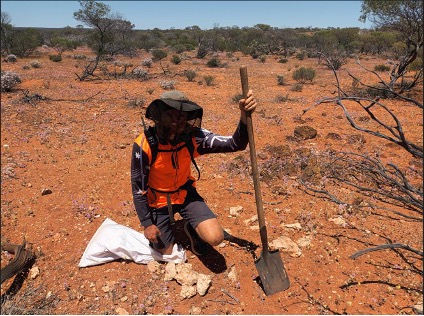Intra Energy Corporation Limited (ASX:IEC) has received encouraging results from exploration being carried out at its flagship Yalgarra Project, in the Murchison region of Western Australia.
Excellent progress has been made, following the Airborne Electro-Magnetic (AEM) survey in July, and completion of the soils geochemical program in October. Results from the first batch of July soils have been returned and are consistent with the results competitors have been reporting from their adjacent licences and boost support for increased exploration activity going into 2023.
“We are encouraged by these early results and the exploration is trending in the right direction to identify multiple high priority targets for closer inspection in 2023. Our partners at Century Minerals, Ed Baltis and Steve Hart, have done a magnificent job in identifying this area and then skilfully executing the early-stage exploration,” Managing Director Benjamin Dunn said.
“It will take time to effectively explore the licence, due to its large size and it being split into a Northern Block and Southern Block. The soil work in particular has been physically demanding, but it is exciting to work an area that has not previously been systematically explored.
We are particularly excited about the elevated copper readings in the west of the Northern Block and pleasantly surprised by the unexpected lithium hits in the North-East of the Northern Block. Both areas will be the focus of follow up work in early 2023.
To already have three prospects with only one-third of the samples analysed, is very exciting for the shareholders of IEC as we head into 2023.”
Led by IEC’s partners in the Yalgarra Project, Century Minerals, a comprehensive programme of widely spaced soil sampling was undertaken over a large part of the licence area comprising approximately 400sq km. Century Minerals had identified the area as potentially hosting mafic/ultramafic rocks similar to Chalice Mining Limited’s “Julimar” project as well as younger mafic intrusives potentially prospective for chonolith-style nickel mineralisation.
Field reconnaissance mapping whilst collecting soils and the airborne AEM survey have since validated the initial rationale used in identifying and exploring the ground.
Lithium
Unexpectedly, a total of 12 samples from the July batch of soil samples sent to Intertek, returned weakly anomalous plus 20 ppm Li assays with a peak Li assay of 28.7 ppm. Resamples from 11 of these sample sites have been sent for further analysis at Labwest Laboratories using their Ultrafine+TM method.
Most interesting was the occurrence of eight of these elevated lithium values in soils from the northeast (Hillside) target area. These weakly anomalous Li assays are supported by stronger Cs and Rb assays, possibly indicative of an LCT pegmatite source. Mapping in this area identified sub-cropping pegmatite and some pegmatite rock float has been sent for assaying at Intertek Laboratory.
Although the main goal at Yalgarra has been to find a magmatic sulphide Cu-Ni-PGE deposit, these results encourage us to also pursue further exploration in the area for lithium-bearing pegmatites.
Next Steps
While the company is waiting on the soil sampling results from the Southern Yalgarra block that have just been collected, the exploration focus will be over the strong targets identified in the Northern Block and further targets immediately identified by the soil geochemistry results as they become available for the Southern Block.
IEC and Century Minerals are examining the most efficient path towards drilling the high priority targets, which may include further infill soil sampling, hand auguring and/or Moving EM Loop or IP electrical surveys to further target identification and confirm drill ready status.
It is intended to commence this further exploration in February 2023 with the intention to focus in on high priority drill targets for testing in H2 CY 2023.
For further information please visit: https://intraenergycorp.com.au/












